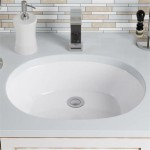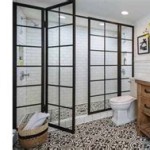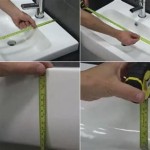How To Organize Under A Small Bathroom Sink
Optimizing storage space in a small bathroom often presents a significant challenge, particularly under the sink. This area, frequently plagued by clutter and disorganization, can be transformed into a functional and efficient storage hub with strategic planning and implementation. An organized space under the bathroom sink not only maximizes available storage but also contributes to a more aesthetically pleasing and efficient bathroom environment.
Before initiating any organizational efforts, it is crucial to assess the existing situation. This involves removing all items from under the sink to gain a clear understanding of the available space and current storage habits. Discard any expired or unused products, consolidate duplicates, and categorize remaining items based on their purpose and frequency of use. This initial assessment provides a foundation for developing an effective organizational strategy tailored to individual needs and storage requirements.
The presence of plumbing presents a unique obstacle when organizing under the bathroom sink. Careful consideration must be given to the placement of storage solutions to avoid obstructing pipes and ensuring easy access for maintenance and repairs. Adapting organizational techniques to accommodate these structural limitations is essential for creating a functional and accessible storage space.
Utilizing Vertical Space with Stackable Drawers and Shelves
In a small bathroom, maximizing vertical space is paramount. Under the sink, this can be achieved through the use of stackable drawers and shelves. These solutions provide distinct levels of storage, allowing for the compartmentalization of various items and preventing clutter from accumulating. Selecting storage units made from durable, moisture-resistant materials is crucial to withstand the humid bathroom environment and ensure longevity.
Stackable drawers are particularly effective for storing smaller items such as cotton swabs, makeup, and travel-sized toiletries. They offer easy access to these items while keeping them neatly organized and contained. Look for drawers with clear fronts to easily identify the contents without having to open each drawer individually. Adjustable dividers can also be incorporated into the drawers to further customize the storage space and prevent items from shifting around.
Shelves, on the other hand, are better suited for larger items such as cleaning supplies, extra hand towels, and hair styling tools. Adjustable shelves offer flexibility in accommodating different item heights and can be reconfigured as storage needs evolve. When selecting shelves, consider the depth and width of the under-sink cabinet to ensure a proper fit and avoid obstructing the door or any plumbing fixtures.
Consider incorporating a tiered shelf organizer. These organizers effectively double or triple the available shelf space, allowing for efficient storage of multiple items. Tiered organizers are particularly useful for storing bottles of varying sizes, ensuring that all items are visible and easily accessible.
When installing shelves or drawers, it's important to measure the available space accurately. Take into account the height of the plumbing fixtures and the depth of the cabinet to ensure the chosen storage solutions fit properly and do not impede the functionality of the sink. Proper installation is key to ensuring the stability and longevity of the storage units.
Employing Over-the-Door Organizers and Baskets
The bathroom cabinet door, often overlooked, represents a valuable storage opportunity. Over-the-door organizers and baskets can be easily attached to the inside of the door, providing additional storage for frequently used items such as hairbrushes, combs, and cleaning cloths. These organizers are particularly effective for maximizing space in small bathrooms where counter space is limited.
Over-the-door organizers come in various configurations, including pockets, hooks, and shelves. The choice of organizer depends on the types of items being stored and the overall aesthetic of the bathroom. Opt for organizers made from lightweight, durable materials that are easy to clean and resistant to moisture. Clear pockets allow for easy visibility of the contents, while hooks are ideal for hanging items such as sponges and scrub brushes.
Baskets, attached to the door using hooks or adhesive strips, offer a more stylish and versatile storage solution. They can be used to store items such as hand towels, washcloths, and toiletries. Choose baskets that complement the bathroom's décor and are the appropriate size for the available space. Woven baskets add a touch of texture and warmth to the bathroom, while wire baskets provide ventilation and prevent moisture buildup.
Before installing an over-the-door organizer or basket, ensure that the door can still close properly without obstruction. Test the chosen organizer with a variety of items to ensure that it can support the weight without damaging the door. Consider using door bumpers to prevent the organizer from scratching or denting the cabinet door.
Over-the-door organizers can also be used to store cleaning supplies, freeing up valuable space under the sink. Store spray bottles and cleaning cloths in the organizer for easy access when needed. This can help to keep the under-sink area clutter-free and prevent spills or leaks from damaging other items.
Utilizing Storage Bins and Containers for Categorized Organization
Once vertical space has been optimized, the remaining area beneath the sink can be further organized using storage bins and containers. The key to effective organization is to categorize items and assign them to specific containers. This prevents clutter from accumulating and makes it easier to find items when needed. Transparent containers are particularly useful as they allow for easy identification of the contents without having to open each container.
Different types of storage bins and containers are available, each suited for specific purposes. Shallow bins are ideal for storing small items such as makeup brushes and cotton balls. Deeper bins can accommodate larger items such as shampoo bottles and cleaning supplies. Choose containers that are the appropriate size for the available space and the items being stored.
Labeling the containers is crucial for maintaining an organized system. Use clear, concise labels to identify the contents of each container. This will help to prevent items from being misplaced and make it easier for others to locate items when needed. Consider using a label maker to create professional-looking labels that are easy to read.
Consider using drawer organizers within the bins to further compartmentalize the contents. Drawer organizers are particularly useful for storing smaller items such as jewelry, hair accessories, and makeup. They help to keep these items neatly organized and prevent them from getting lost or tangled.
Regularly review the contents of the storage bins and containers to ensure that they are still relevant and necessary. Discard any expired or unused items to prevent clutter from accumulating. Rotate items as needed to ensure that frequently used items are easily accessible. This ongoing maintenance is essential for maintaining an organized under-sink area.
Furthermore, consider the material of the bins. While plastic is a common and affordable option, other materials such as woven baskets or metal bins can add a touch of style to the under-sink area. Choose materials that are durable, easy to clean, and complement the overall aesthetic of the bathroom.
In addition to the above, consider the placement of heavy items. Heavier items, such as large bottles of cleaning supplies, should be placed on the bottom shelf or in a sturdy bin to prevent tipping and ensure stability. Lighter items can be placed on higher shelves or in over-the-door organizers.
Finally, ensuring proper ventilation under the sink is crucial for preventing mold and mildew growth. Consider using containers with ventilation holes or leaving a small gap between the containers and the cabinet walls. This will allow air to circulate and prevent moisture buildup. Regularly check the under-sink area for any signs of leaks or moisture and address them promptly to prevent further damage.

25 Brilliant Ways To Organize Under The Bathroom Sink

How To Organize Your Under Bath Sink Cabinet The Container

Under Bathroom Sink Organization Ideas For Small Powder Room Cabinets Blue I Style

Under Bathroom Sink Organization Ideas For Small Powder Room Cabinets Blue I Style

Organizing Under The Bathroom Sink 5 Super Simple Steps

25 Brilliant Ways To Organize Under The Bathroom Sink

4 Tips To Organize Under The Bathroom Sink Clean Mama

15 Ways To Organize Under The Bathroom Sink

Bathroom Organization Under The Sink Organizing Tips Polished Habitat

18 Genius Under The Sink Storage Ideas And Organizers
Related Posts







